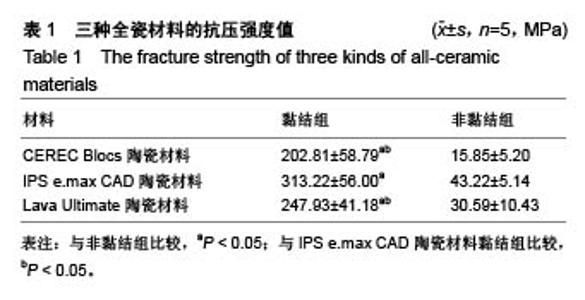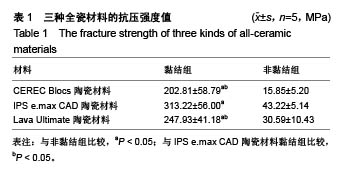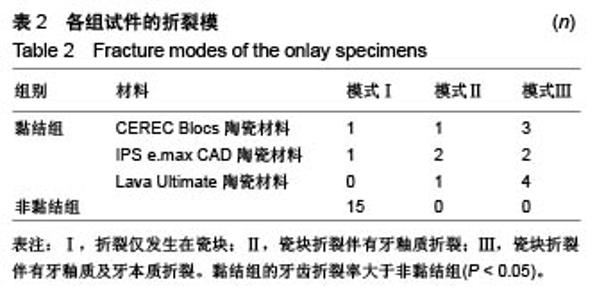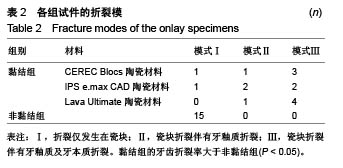| [1] Polesel A.Restoration of the endodontically treated posterior tooth.G Ital Endod.2014;28(1):2-16.[2] 陈智,陈彬.根管治疗后牙体修复的治疗方案选择[J].华西口腔医学杂志, 2015,33(2):115-120.[3] 刘慧丽.全冠与高嵌体修复根管治疗后牙牙体缺损的疗效分析[J].全科口腔医学电子杂志,2015,2(1):46-47. [4] Archibald JJ,Santos GC,Moraes Coelho Santos MJ. Retrospective clinical evaluation of ceramic onlays placed by dental students.J Prosthet Dent.2017.pii:S0022-3913(17)30494-8.[5] Belli R,Petschelt A,Hofner B,et al.Fracture rates and lifetime estimations of CAD/CAM all-ceramic restorations.J Dent Res.2016; 95(1):67-73. [6] 张伟,吴友农.CAD/CAM技术在牙体缺损嵌体修复中的应用[J].口腔医学, 2017,37(7):668-672.[7] 赵昕,战德松.CAD/CAM系统及可切削材料在口腔修复的应用现状[J].中国实用口腔科杂志,2013,6(6):331-337. [8] Collares K,Corrêa MB,Laske M,et al.A practice-based research network on the survival of ceramic inlay/onlay restorations.Dent Mater. 2016;32(5):687-694.[9] Stoll R,Cappel I,Pieper K,et al.Survival of inlays and partial crowns made of IPS empress after a 10-year observation period and in relation to various treatment parameters.Oper Dent.2007;32(6):556-563. [10] Blackburn C,Rask H,Awada A.Mechanical properties of resin-ceramic CAD-CAM materials after accelerated aging.J Prosthet Dent. 2017. pii:S0022-3913(17)30574-7. [11] Awada A,Nathanson D.Mechanical properties of resin-ceramic CAD/CAM restorative materials.J Prosthet Dent.2015;114(4):587-593.[12] 陈岗,陈志飞,顾卫平,等.不同边缘设计椅旁CAD/CAM全瓷高嵌体修复的对比研究[J].口腔医学,2015,35(7):550-552.[13] Lu T,Peng L,Xiong F,et al.A 3-year clinical evaluation of endodontically treated posterior teeth restored with two different materials using the CEREC AC chair-side system.J Prosthet Dent. 2017.pii:S0022-3913 (17)30310-4. [14] Lee SJ,Macarthur RX 4th,GaUucd GO.An evaluation of student and clinician perception of digital and conventional implam impressions.J Prosthet Dent.2013;110(5):420-423.[15] Baroudi K,Ibraheem SN.Assessment of chair-side computer-aided design and computer-aided manufacturing restorations:A review of the literature.J Int Oral Health.2015;7(4):96-104.[16] 周玉.陶瓷材料学[M].哈尔滨:哈尔滨工业大学出版社,1995:102-103.[17] Conrad HJ,Seong WJ,Pesun IJ.Current ceramic materials and systems with clinical recommendations:A systematic review.J Prosthet Dent.2007;98(5):389-404.[18] Belli R,Wendler M,de Ligny D,et al.Chairside CAD/CAM materials. Part 1: Measurement of elastic constants and microstructural characterization. Dent Mater.2017;33(1):84-98. [19] 董星彤,王剑.口腔陶瓷及类陶瓷修复材料的分类和临床应用[J].北京口腔医学,2017,25(2):111-114.[20] Egbert JS,Johnson AC,Tantbirojn D,et al.Fracture strength of ultrathin occlusal veneer restorations made from CAD/CAM composite or hybrid ceramic materials.Oral Sci Int.2015;12(2):53-58. [21] 陈曦,章非敏,胡建.两种不同厚度椅旁CAD/CAM全瓷材料断裂强度的实验研究[J].南京医科大学学报(自然科学版),2015,35(11):1632-1636.[22] Aboushelib MN,Elsafi MH.Survival of resin infiltrated ceramics under influence of fatigue. Dent Mater.2016;32(4):529-534. [23] Gresnigt MM,Schipper L,Cune MS,et al.Fracture strength, failure type and Weibull characteristics of lithium disilicate and multiphase resin composite endocrowns under axial and lateral forces. Dent Mater.2016; 32(5):607-614. [24] Ferrario VF,Sforza C,Serrao G,et al.Single tooth bite forces in healthy young adults.J Oral Rehabil.2004;31(1):18-22. [25] Magne P,Schlichting LH,Paranhos MP.Risk of onlay fracture during pre-cementation functional occlusal tapping.Dent Mater.2011;27(9): 942-947.[26] Magne P,Stanley K,Schlichting LH.Modeling of ultrathin occlusal veneers.Dent Mater.2012;28(7):777-782.[27] 杨瑞,张修银,韩智慧,等.不同基底对Sirona CEREC Blocs可切削陶瓷断裂强度的影响[J].口腔颌面修复学杂志,2013,14(4):231-234.[28] Abd Wahab MH,Bakar WZ,Husein A.Different surface preparation techniques of porcelain repaired with composite resin and fracture resistance.J Conserv Dent.2011;14(4):387-390. [29] Clelland NL,Warchol N,Kerby RE,et al.Influence of interface surface conditions on indentation failure of simulated bonded ceramic onlays. Dent Mater.2006;22(2):99-106.[30] Yildiz C,Evren B,Uludamar A,et al.Fracture resistance of manually and CAD/CAM manufactured ceramic onlays.J Prosthodont.2013;22(7): 537-542.[31] Johnson AC,Versluis A,Tantbirojn D,et al.Fracture strength of CAD/CAM composite and composite-ceramic occlusal veneers.J Prosthodont Res.2014;58(2):107-114. |





